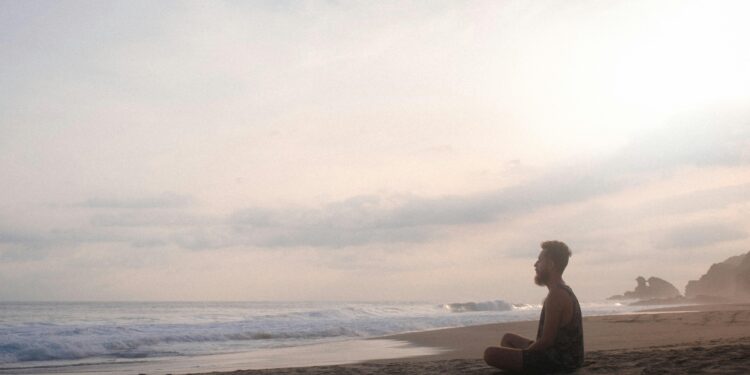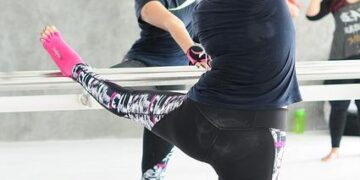Table of Contents
For over a decade, my life was wallpapered with quotes.
“Be the best version of yourself,” Stephen Curry urged from a Post-it on my monitor.1
“True nobility is being superior to your former self,” Hemingway reminded me from a framed print on my desk.2
My days were a relentless, caffeine-fueled chase after an idealized, flawless version of me that always remained just out of reach.
I was a devout practitioner in the church of self-improvement, a multi-billion dollar industry built on the promise of becoming.3
This pursuit, however, became a source of profound anxiety and burnout.
The very language of “becoming” implied my current self was perpetually inadequate, a rough draft in need of constant, aggressive editing.4
This endless striving, which philosophy has long examined as the complex and often fraught process of attaining self-knowledge, was for me a source not of wisdom, but of deep-seated fragility.6
The breaking point came during a high-stakes project at work.
I was leading a team on a critical launch, and my obsession with perfection became my undoing.
I was terrified of judgment, of delivering anything less than a flawless result.
This fear, a classic symptom of what I would later learn is maladaptive perfectionism, led to a state of analysis paralysis.7
I second-guessed every decision, demanded endless revisions, and drove my team—and myself—to the brink.
We missed key deadlines.
The project, which was supposed to be a career-defining success, collapsed in a spectacular failure.
This wasn’t just a professional setback; it was a personal break.
The very framework I had used to build my life—the belief that striving for perfection would make me stronger—had shattered.
It forced me to confront a terrifying truth: the standard advice hadn’t made me resilient; it had made me brittle.
The problem wasn’t that I had failed to reach my “best self.” The problem was that the “best self” was a flawed blueprint from the start, a psychological trap designed to ensure I always felt like I was falling short.
Part I: The Architecture of Unhappiness – Deconstructing the Myth of Perfection
My journey to understand what went wrong began with a hard look at the very foundation of my beliefs.
I had to deconstruct the myth of the perfect self that had held me captive for so long.
The Philosophical Mirage of a Perfect Self
The modern self-help movement often presents the “self” as a project to be optimized, a product to be perfected.
But this view is a dramatic oversimplification.
Philosophers from Descartes to Hume have wrestled with the nature of the self, proposing it is not a static object but a dynamic activity, a narrative we construct, or a shifting bundle of perceptions.6
The idea of a single, fixed “best” version is a philosophical fallacy.
The self is a process, not a destination.
This is where the goals of philosophy and pop self-help diverge.
Philosophy seeks to understand the nature of reality, even if the answers are complex or unsettling.9
In contrast, much of the self-help industry offers simple, feel-good solutions with little rigorous support, often creating an addictive cycle where we consume motivation but fail to put it into practice.9
The “best self” I was chasing wasn’t a philosophical truth; it was a commercial product sold to me as an ideal.
The Psychological Prison of Maladaptive Perfectionism
The engine driving my pursuit was a psychological condition I didn’t even have a name for: maladaptive perfectionism.
Psychologists distinguish between two types.
Adaptive perfectionism involves setting high but realistic standards and deriving satisfaction from the process of striving.
It’s flexible and healthy.
Maladaptive perfectionism, on the other hand, is a prison built from unrealistic standards, harsh self-criticism, and a debilitating fear of failure.10
My life had become a case study in the latter.
This condition is the hidden root of the most common challenges people face on their personal growth journeys.
We are often told to tackle problems like procrastination, fear, and negative self-talk with isolated “hacks” or “tips.” But this is like treating the cough without diagnosing the pneumonia.
These issues are not separate diseases; they are interconnected symptoms of the underlying pathology of maladaptive perfectionism.
The core belief, “I must be perfect,” creates an intense fear of imperfection.
This fear manifests as anxiety about judgment, which in turn triggers procrastination as a defense mechanism to avoid producing a flawed result.7
This entire toxic system is policed by a “critical inner voice,” that relentless narrator of our inadequacy.13
The psychic energy required to maintain this internal war inevitably leads to burnout and, for many, depression.10
You cannot “hack” your way out of procrastination if the deep-seated terror of not being good enough remains untouched.
The entire paradigm must be replaced.
Part II: The Epiphany – Discovering the Art of Golden Repair (Kintsugi)
In the quiet aftermath of my professional collapse, feeling lost and utterly disillusioned with the self-help platitudes that had failed me, I stumbled upon an image that changed everything.
It was a photograph of a simple ceramic bowl, crisscrossed with veins of shimmering gold.
It was a Kintsugi bowl.
Kintsugi (金継ぎ), which translates to “golden joinery,” is the centuries-old Japanese art of repairing broken pottery.
Instead of trying to hide the damage, the craftspeople use a special lacquer mixed with powdered gold, silver, or platinum to mend the pieces, intentionally highlighting the cracks.15
The philosophy is revolutionary: the break is not a source of shame to be concealed.
It is an integral part of the object’s history, a scar that, when honored, makes the object more beautiful, more unique, and more valuable than it was before it was broken.17
This art form is the physical manifestation of a deeper Japanese aesthetic and philosophy known as wabi-sabi (侘寂).
Wabi-sabi is a worldview centered on the acceptance of transience and imperfection.
It is the practice of finding beauty in things that are “imperfect, impermanent, and incomplete”.19
It celebrates the grace of natural simplicity and flawed beauty, a profound counter-narrative to the Western obsession with flawlessness.
In that moment, I realized Kintsugi offered a vastly superior metaphor for resilience and personal growth.
The common Western metaphors—”bouncing back” or “what doesn’t kill you makes you stronger”—are about recovery, about returning to a pre-damaged state.21
But we don’t just “bounce back” from significant failure or trauma.
We are fundamentally changed by it.
Kintsugi acknowledges this transformation.
It provides a framework where the reshaping isn’t a scar to be hidden but a defining feature to be honored with gold.
It reframes damage not as a liability, but as a prerequisite for a deeper, more intricate, and more authentic form of beauty.
Part III: The Kintsugi Method – A Framework for Mending a Broken Self
This new paradigm gave me more than just comfort; it gave me a method.
The ancient process of Kintsugi became a practical framework for rebuilding myself, not into a “perfect” version, but into a more whole and resilient one.
Pillar 1: Acknowledging the Break (Radical Self-Awareness)
The Kintsugi process can only begin after a vessel is broken.
You cannot mend what you pretend is whole.
For us, this is the practice of radical self-awareness and unflinching honesty.
It means looking at our failures, our mistakes, and our perceived shortcomings without denial, judgment, or rationalization.23
It requires, as Carl Jung suggested, understanding that “everything that irritates us about others can lead us to an understanding of ourselves”.24
This is the courageous first step of embracing the discomfort of the truth, knowing that growth requires us to move forward from where we actually are, not from where we pretend to be.2
Pillar 2: Gathering the Pieces (The Practice of Self-Compassion)
A Kintsugi artisan carefully gathers every shard of the broken vessel, no matter how small or seemingly insignificant.
Nothing is discarded as worthless.
This is the human work of self-compassion.
After a failure, our perfectionistic inner critic screams at us to judge, condemn, and discard the “broken” parts of ourselves.
Self-compassion is the act of quieting that voice and treating ourselves with the same warmth, kindness, and understanding we would offer a dear friend in pain.14
According to the pioneering research of Dr. Kristin Neff, self-compassion consists of three core components that work together to form the “lacquer” that can bind our pieces back together 11:
- Self-Kindness vs. Self-Judgment: Choosing to be gentle and understanding with ourselves when we suffer or fail, rather than berating ourselves.
- Common Humanity vs. Isolation: Recognizing that imperfection, failure, and difficulty are universal parts of the shared human experience, not isolating personal defects.
- Mindfulness vs. Over-identification: Observing our painful thoughts and emotions with balanced awareness, neither suppressing them nor letting them consume us.
An extensive body of research confirms that self-compassion is a powerful antidote to the toxic effects of maladaptive perfectionism.
It acts as a buffer, significantly reducing depression and anxiety and fostering the very personal growth initiative that perfectionism so often stifles.10
Pillar 3: Applying the Lacquer & Gold (The Work of Integration & Transformation)
Once the pieces are gathered with compassion, the artisan begins the slow, deliberate work of mending.
The lacquer and gold are painstakingly applied, not just to repair the vessel, but to transform it.
This is the active work of healing, learning, and reframing our personal narrative.
It is where we turn our scars into strength.
This process of transformation is a lot like metallurgy.
A blacksmith takes raw, base metal and subjects it to intense heat and pressure.
It is through this stressful forging process that impurities are burned away and the metal is tempered into a strong, resilient, and useful blade.27
Our struggles are the fire and the hammer that forge our character, transforming the raw material of our experience into the tempered steel of wisdom and resilience.
It is also like rebuilding a structure using sound architecture.
When a building collapses due to a flawed foundation, you don’t just patch the cracks in the walls.
You excavate the site, understand the structural failure, and rebuild upon a new, “precious cornerstone” of solid principles.29
My own professional failure was a collapse of my life’s architecture.
By integrating the lessons from that break, I built a new foundation based on authenticity and empathy rather than perfectionism.
The “gold” that now lines my cracks is a unique understanding of failure that allows me to connect with and help others in a way my “perfect” former self never could have.
My break became my breakthrough.
Part IV: Living a Mended Life – A Gallery of Imperfect Masterpieces
Adopting the Kintsugi philosophy requires a fundamental shift in how we view ourselves and our journey.
It is a move away from chasing a flawless ideal and toward embracing a beautiful, mended wholeness.
The Flawless Self vs. The Kintsugi Self: Two Blueprints for Growth
| Feature | The Flawless Self (The Old Paradigm) | The Kintsugi Self (The New Paradigm) |
| View of Failure | An event to be avoided at all costs; a sign of inadequacy. | An inevitable part of life; an opportunity for transformation. |
| View of Flaws | Weaknesses to be hidden, fixed, or eliminated. | A unique part of one’s story; a source of beauty and strength. |
| Primary Motivation | Fear of judgment; pursuit of external validation. | Self-compassion; pursuit of authentic growth. |
| Source of Self-Worth | Conditional; based on performance and achievement. | Unconditional; inherent to being human. |
| Inner Dialogue | The Critical Inner Voice; “You are not good enough.” | The Compassionate Voice; “You are human, and that is enough.” |
| Core Metaphor | A perfect, unbroken statue. | A mended Kintsugi bowl, more beautiful for having been broken. |
| Ultimate Goal | Perfection; arriving at a flawless final state. | Wholeness; embracing the entire journey, breaks and all. |
| Emotional Result | Anxiety, burnout, fragility. | Resilience, authenticity, strength. |
A Re-Interpreted Gallery of Quotes
With this new lens, we can return to the world of inspirational quotes not as commands to be perfect, but as reflections on the art of living a mended life.
For Acknowledging the Break (Radical Self-Awareness):
- “If there is no struggle, there is no progress.” – Frederick Douglass 2
- “This is the very perfection of a man, to find out his own imperfections.” – Saint Augustine 31
- “Life is very interesting… in the end, some of your greatest pains become your greatest strengths.” – Drew Barrymore 22
For Gathering the Pieces (Self-Compassion):
- “The curious paradox is that when I accept myself just as I am, then I can change.” – Carl R. Rogers 32
- “Stop trying to ‘fix’ yourself; you’re NOT broken! You are perfectly imperfect and powerful beyond measure.” – Steve Maraboli 31
- “You’re imperfect, and you’re wired for struggle, but you are worthy of love and belonging.” – Brené Brown 31
For Applying the Gold (Transformation & Strength):
- “The world breaks everyone, and afterward, some are strong at the broken places.” – Ernest Hemingway 22
- “Rock bottom became the solid foundation on which I rebuilt my life.” – J.K. Rowling 21
- “Your willingness to fail equates to your acceptance to succeed.” – Jonas Caino 33
For Embracing Wholeness (The Mended Masterpiece):
- “There is a crack, a crack in everything / That’s how the light gets in.” – Leonard Cohen 34
- “Imperfection is beauty, madness is genius and it’s better to be absolutely ridiculous than absolutely boring.” – Marilyn Monroe 31
- “Do the best you can until you know better. Then when you know better, do better.” – Maya Angelou 2
Conclusion: Your Unique Pattern of Gold
Looking back, I no longer see my life as a project to be perfected.
The failures and setbacks I once saw as shameful blemishes I now see as the intricate, golden seams that give my life its unique pattern, its depth, and its value.
I am no longer chasing a flawless, imaginary version of myself.
I am learning to cherish the beautifully mended person I am today.
This is my invitation to you.
Stop seeing yourself as a flawed project that needs fixing.
Start seeing yourself as a masterpiece in progress, a vessel with a rich and unique history.
The goal is not to avoid the breaks that are an inevitable part of a life fully lived.
The goal is to learn the art of mending with gold—with self-awareness, with compassion, and with the wisdom that comes only from integrating our deepest struggles.
As the great Maya Angelou said, “I can be changed by what happens to me.
But I refuse to be reduced by it”.21
The philosophy of
Kintsugi takes this one step further.
We are not just not reduced by what happens to us; we can be profoundly enhanced by it.
Our journey is to discover, and to cherish, our own unique and beautiful pattern of gold.
Works cited
- “Be the best version of yourself in anything you do. You don’t have to live anybody else’s story.” -Stephen Curry : r/quotes – Reddit, accessed August 10, 2025, https://www.reddit.com/r/quotes/comments/3zq3vl/be_the_best_version_of_yourself_in_anything_you/
- 50 Best Personal Growth Quotes for Everyday Evolution, accessed August 10, 2025, https://www.snhu.edu/about-us/newsroom/education/personal-growth-quotes
- The Philosophy of Self-Improvement | The Art of Manliness Podcast, accessed August 10, 2025, https://www.annakschaffner.com/post/the-philosophy-of-self-improvement-the-art-of-manliness-podcast
- Becoming Your Favourite Self | Psychology Today, accessed August 10, 2025, https://www.psychologytoday.com/us/blog/everyday-resilience/202407/becoming-your-favourite-self
- The Hard Truth of Becoming Your Best Self – Christopher D. Connors, accessed August 10, 2025, https://www.chrisdconnors.com/post/the-hard-truth-of-becoming-your-best-self
- Self-Knowledge – Stanford Encyclopedia of Philosophy, accessed August 10, 2025, https://plato.stanford.edu/entries/self-knowledge/
- Personal Growth Simplified – 20 Common Struggles Turned Into Action – Promoted Resume, accessed August 10, 2025, https://www.promotedresume.com/blog/personal-growth-simplified-20-common-struggles-turned-into-action
- Philosophy of self – Wikipedia, accessed August 10, 2025, https://en.wikipedia.org/wiki/Philosophy_of_self
- How to Differentiate Philosophy from Self-Help? : r/askphilosophy – Reddit, accessed August 10, 2025, https://www.reddit.com/r/askphilosophy/comments/j05zwi/how_to_differentiate_philosophy_from_selfhelp/
- Self-Compassion Counterbalances Maladaptive Perfectionism …, accessed August 10, 2025, https://www.psychologytoday.com/us/blog/the-athletes-way/201802/self-compassion-counterbalances-maladaptive-perfectionism
- Well-Being and Perfectionism: Assessing the Mediational Role of Self-Compassion in Emerging Adults, accessed August 10, 2025, https://pmc.ncbi.nlm.nih.gov/articles/PMC11119223/
- The Role of Self-Compassion Among Adaptive and Maladaptive Perfectionists in University Students – American Psychological Association, accessed August 10, 2025, https://www.apa.org/education-career/ce/self-compassion-perfectionism.pdf
- How to Become Your Best Self – PsychAlive, accessed August 10, 2025, https://www.psychalive.org/how-to-become-your-best-self/
- Why is self compassion so hard? How Perfectionists Can Struggle With Self-Compassion, accessed August 10, 2025, https://manhattantherapycollective.com/blog-manhattan-therapy-collective/why-is-self-compassion-so-hard-perfectionism
- Kintsugi Meaning & Philosophy: Finding Resilience in Life’s Cracks – Millennium Gallery JP, accessed August 10, 2025, https://millenniumgalleryjp.com/en-ca/blogs/journal/the-art-of-resilience-kintsugis-meaning-and-philosophy
- Kintsugi Philosophy: Make Failure Manageable and Beautiful – Rumie Learn, accessed August 10, 2025, https://learn.rumie.org/jR/bytes/too-hard-on-yourself-for-making-mistakes-use-kintsugi-philosophy-to-make-failure-manageable-and-beautiful/
- My ultimate self improvement moment was discovering a Japanese method for repairing broken pottery. : r/selfimprovement – Reddit, accessed August 10, 2025, https://www.reddit.com/r/selfimprovement/comments/1jjk5sn/my_ultimate_self_improvement_moment_was/
- The Philosophy of Kintsugi, accessed August 10, 2025, https://kintsugi-kit.com/blogs/tsugu-tsugu-columns/philosophy-of-kintsugi
- Wabi-Sabi: The Japanese Art of Finding the Beauty in Imperfections – Carnegie Library of Pittsburgh, accessed August 10, 2025, https://www.carnegielibrary.org/staff-picks/wabi-sabi-the-japanese-art-of-finding-the-beauty-in-imperfections/
- Wabi-sabi – Wikipedia, accessed August 10, 2025, https://en.wikipedia.org/wiki/Wabi-sabi
- 80 Empowering Resilience Quotes to Overcome Life’s Challenges – Mindfulness Exercises, accessed August 10, 2025, https://mindfulnessexercises.com/resilience-quotes/
- 61 Quotes About Strength And Resilience For Uncertain Times – Southern Living, accessed August 10, 2025, https://www.southernliving.com/culture/quotes-about-strength
- The Top 10 Barriers To Self-Growth – Dr. Stan Hyman, accessed August 10, 2025, https://drstanhyman.com/top-10-barriers-to-self-growth/
- Top 10 Self-Awareness Quotes – Nally Ventures Leadership, accessed August 10, 2025, https://www.nallyventuresleadership.com/2022/01/20/top-self-awareness-quotes/
- Self-Compassion as a Mediator Between Perfectionism and Personal Growth Initiative, accessed August 10, 2025, https://self-compassion.org/wp-content/uploads/2020/09/Umandap-Teh2020.pdf
- Self-Compassion as a Mediator of Maladaptive Perfectionism and Depressive Symptoms in College Students, accessed August 10, 2025, https://self-compassion.org/wp-content/uploads/2016/06/Mehr_Adams_2016.pdf
- Transformation of Metal into Metaphor – Ganoksin Jewelry Making Community, accessed August 10, 2025, https://www.ganoksin.com/article/transformation-of-metal-metaphor/
- Alchemy, Archaic, and Industrial: A Spirituality of Metallurgy – Theophaneia, accessed August 10, 2025, https://www.theophaneia.org/alchemy-archaic-and-industrial-a-spirituality-of-metallurgy/
- John Onians: ‘Architecture, Metaphor and the Mind’ – Thomas Deckker Architect Commentary, accessed August 10, 2025, https://www.thomasdeckker.co.uk/commentary/onians.htm
- Architectural Metaphors for the Christian Life – Tabletalk Magazine, accessed August 10, 2025, https://tabletalkmagazine.com/article/2019/06/architectural-metaphors-for-the-christian-life/
- 45 Imperfection Quotes to Embrace Your Flaws (LOVE), accessed August 10, 2025, https://graciousquotes.com/imperfection/
- 24 Quotes To Help You Be Your Best Self – MindJournal, accessed August 10, 2025, https://mindjournals.com/blogs/read/be-your-best-self-quotes
- Be The Best Version Of You Quotes – Goodreads, accessed August 10, 2025, https://www.goodreads.com/quotes/tag/be-the-best-version-of-you
- 17 Quotes To Help You Embrace Imperfection, accessed August 10, 2025, https://inspiringquotes.com/17-quotes-to-help-you-embrace-imperfection/
- The Best “Be Yourself” Quotes to Embrace Who You Are – Psych Central, accessed August 10, 2025, https://psychcentral.com/health/be-yourself-inspiring-quotes






